In Lebanon, farmers who once grew marijuana and poppy are trying their hand at Syrah and Tempranillo.
We climb Mount Lebanon, which rises rapidly from the Mediterranean. Navigating the narrow, rutted roads, we cut through a landscape littered with lush ravines and barren quarries; rivers dyed red with topsoil runoff, which the ancients believed to be the blood of Adonis; olive trees, firs, and cedars; and red-roofed homes that dot once-picturesque villages now covered by concrete. After making a hairpin turn at the top, we arrive—abruptly—in the Bekaa Valley, a sun-soaked, patchy plain that the Romans called the “breadbasket of the world.”
We’re almost there: Dayr al-Ahmar, a village huddled beneath the northern peaks.
This is an inland frontier—a place where the mountain meets the plain, I say to Sam, an intrepid photojournalist who’s excited about the trip but quickly learning to ignore me. Over the past few centuries, people have migrated from inhospitable climes in search of pasturelands and fields to farm.
But wait. It’s time to stop the meditations and musings. We’ve missed our turn.
Now driving determinedly, we ignore the scenery and skip the historical sites. We’re here to drink wine.
Farmers here used to grow cannabis and opium poppies destined for the hash and heroin trade. Now, they grow grapes: Cabernet Sauvignon, Syrah, Tempranillo, and more. Working together in the Cooperative Coteaux d’Heliopolis—or the “Heliopolis Cooperative,” inspired by the Hellenic name for Baalbek, a major nearby town—farmers in the area have been supplying grapes to Lebanon’s largest wineries since the early 2000s.
The farmers make wine, too. With the help of winemakers, the co-op has created two new labels: Coteaux Les Cedres and Day‘aa, an Arabic-labeled wine that derives its name, and incorporates the imagery of, a Lebanese village. A few of the farmers are launching their own private winery, Couvent Rouge, through which they hope to further help other farmers—and, of course, turn a profit.
People have been growing grapes and making wine in the Bekaa Valley for millennia. “There was an uninterrupted wine culture in Lebanon even before the Jesuits [revitalized winemaking] in 1857,” says Michael Karam, the Lebanese-British author of Lebanese Wines. The Jesuits’ “game changer was that they made a dry wine” and “laid the foundations of the modern wine industry. Then, with the collapse of the Ottoman Empire and the arrival of the French, things really began to motor,” he adds.
There is no evidence that wine was purged from the region
But long before the Jesuits, the Phoenicians, a seafaring people who lived on the Levantine coast in ancient times, made and traded wine all around the Mediterranean. Locals kept making wine under the Hellenic, Assyrian, Babylonian, Roman, and Byzantine rulers that passed through Lebanon during the next couple thousand years.
And they did so under the Muslim—Arab, Persian, Egyptian, Turkic, and Turkish—rulers that governed the area, with a few Crusader interludes, from the fall of Rome until the collapse of the Ottoman Empire after World War I. Christians made wine for sacrament and private consumption, which is why viticulture survived—though it did atrophy—under the Ottomans, who tried to ban the making and consumption of wine except for religious purposes. Monks flourished as winemakers. Monasteries throughout the Middle East became halls of hospitality, and then hedonism, for Muslim travelers and visitors. And, anyway, Muslims were not as uniformly opposed to wine—or its effects—as contemporary stereotypes and simplifications suggest.
“There is no evidence that wine was purged, or extirpated, from the region,” says Alex Rowell, author of the forthcoming Vintage Humor: The Islamic Wine Poetry of Abu Nuwas, as he swills a “not offensive” white wine outside of a Beirut café. “Caliphs, from the Umayyad era onwards, were drinkers. Some [were] enthusiastic imbibers.”
Abu Nuwas, the “master” of the Arabic wine poem, even mentioned Lebanon “at least three times.” Once, he requested that “if he died in the lands of the Levant, then he not be left too far from Firzul”—a grape-growing town that still stands just 25 miles south of Dayr al-Ahmar.

Locals have also been planting much more potent—and lucrative—crops for centuries: cannabis and opium poppies. They increased production to meet export-driven demand after Lebanon became an independent state in 1943.
In the 1950s, with Lebanon emerging as a free-wheeling “merchant republic,” people found plenty of opportunities for debauched endeavors. Beirut boomed. It became a global center for finance, trade, travel, and shipping; it also became a crime center. With complicit bankers and officials, Lebanese criminals helped run some of the most prominent drug rings in the world—including, for instance, the infamous French Connection and ventures linked to the mafia.
The drug trade exploded in the 1970s and 1980s. Even as global consumers demanded more hash, heroin, and cocaine—driving up prices and profits—the state collapsed completely during the Lebanese civil war, which lasted from 1975-1991. Left to their own devices, farmers began cultivating more cannabis and opium. The Bekaa Valley became a drug lord’s paradise; drugs became its people’s petroleum.
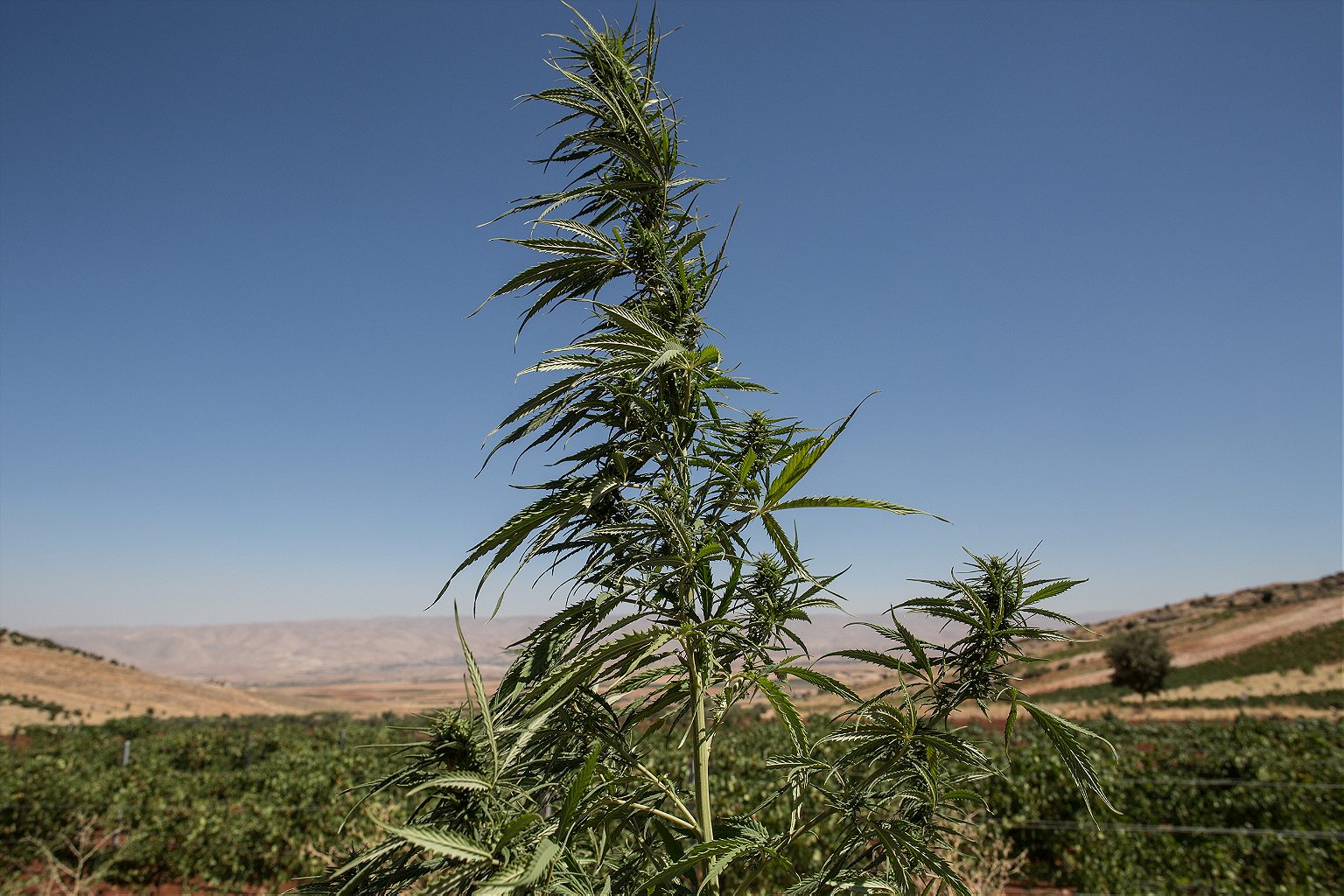
Everyone wanted a cut. Rapacious militias and foreign armies controlled the Bekaa Valley, overland transit routes, and a dozen seaports to the wider world. Moving thousands of tons of hash, cocaine, and heroin, they pocketed hundreds of millions of dollars. Then, they used the money to buy guns, pay more gunmen, and fight each other. After the Syrian regime monopolized control of the Bekaa Valley, going so far as to send in units of its presidential guard, it stabilized the drug trade and began to benefit from billions of dollars in related revenue. By 1990, Lebanese farmers were producing 80 percent of the world’s cannabis and a significant share of its opium poppies—leading the U.S. Congress to hold hearings on “the world’s largest drug farm.”
After that, the authorities began serious eradication campaigns, in part to placate the Clinton administration, which was pushing for peace between Syria and Israel. They razed fields, burned crops, and shut down processing facilities. In 1997, the United States removed Lebanon from its list of narcotics-trafficking states.
But farmers couldn’t find adequate alternatives for their illicit crops, despite Lebanese and international attempts to help. In the 1990s, the U.S. Agency for International Development (USAID) tried to encourage dairy-farming and ultimately supported the purchase of nearly 5,000 cows. “Something went wrong,” a farmer mutters as we walk through a small slice of land north of Dayr al-Ahmar. “We didn’t see a single cow. Maybe there were thousands of cows. Some son of a bitch probably stole them!”
Do you know how much a unit of hash is? You want people to grow potatoes?!
Then, in the 2000s, the Lebanese government tried to encourage farmers to grow potatoes. “Really?” another farmer asks, incredulously, while he drives us around some cannabis fields in the area. “Do you know how much [a unit] of hash is? You want people to grow potatoes?!”
Farmers in the area, we discover through a sloppy sort of Socratic dialogue with the driver, can’t make a living growing apples because the lands “are too low and hot;” barley or wheat, because “most farmers don’t own plots of land large enough for such cheap crops;” or figs, cherries, or other fruits, because, well, “nobody eats jam or jelly anymore!”
Caught between aggressive eradication campaigns and ineffective crop-substitution initiatives, some farmers decided to grow grapes, turning weed into wine.
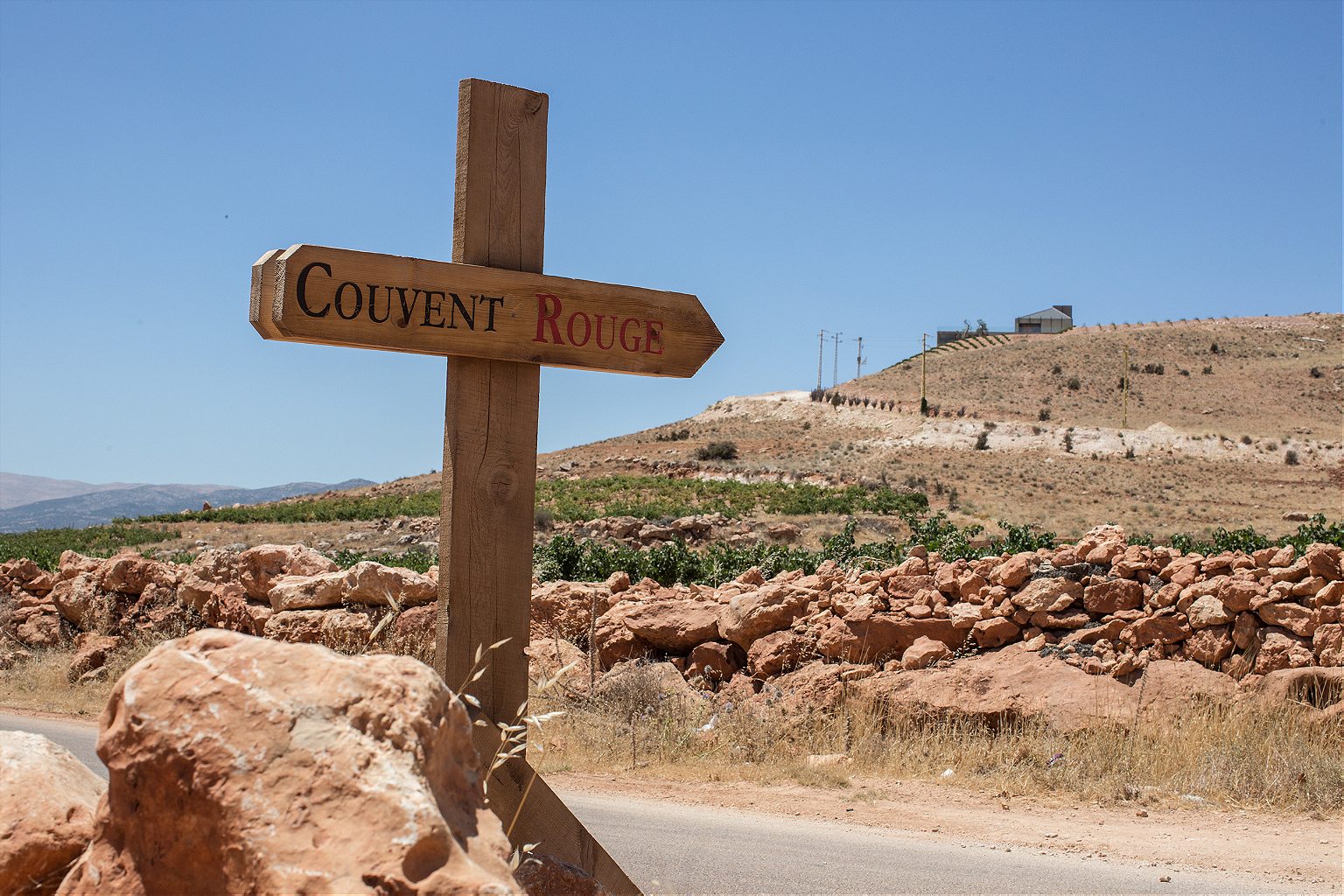
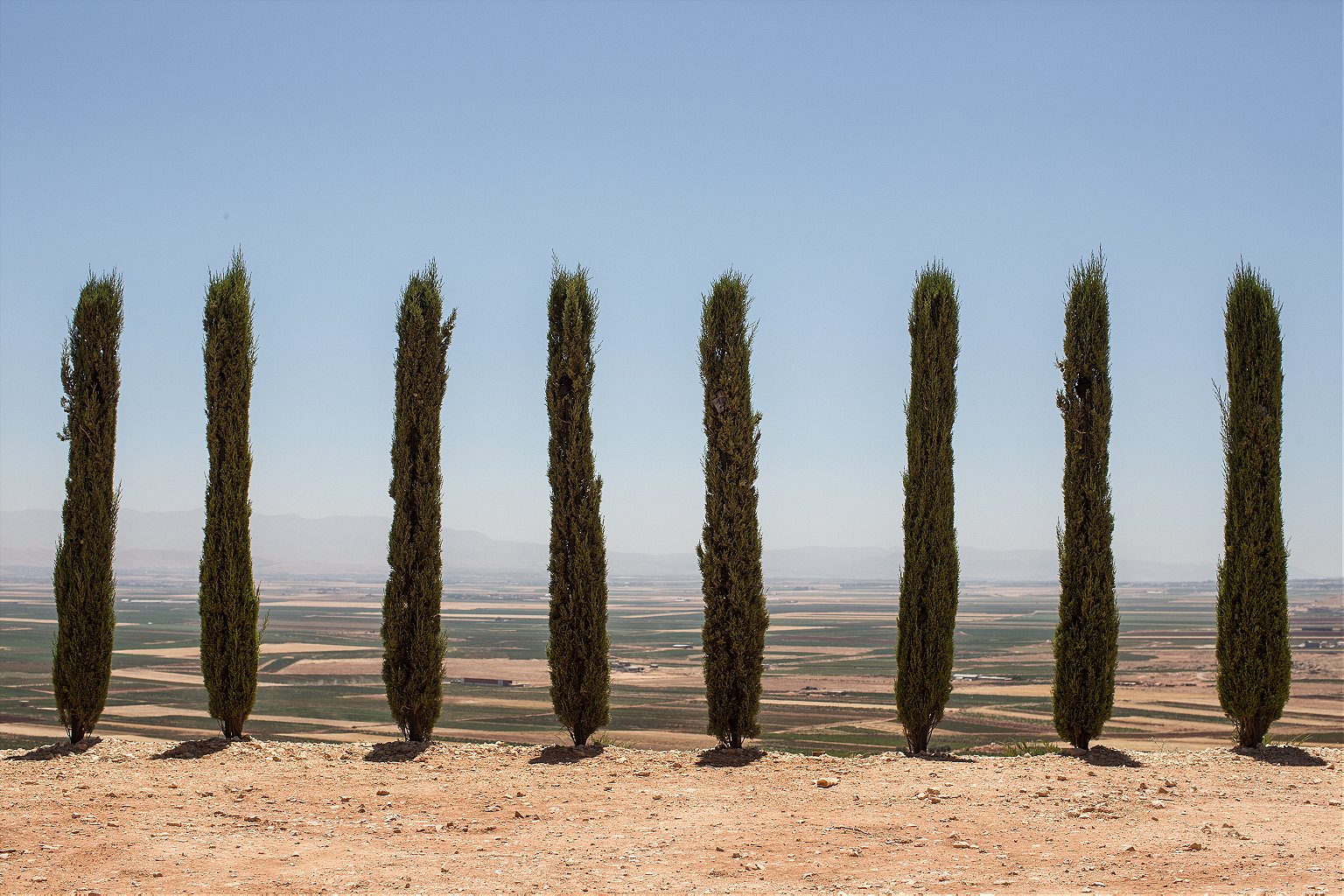
We see Couvent Rouge in the distance: a concrete bunker, angular but still elegant, perched on a hill like a Galactic Empire command center in the Levant.
Walid Habshi ushers us in, makes small talk, and sits down in a room that overlooks the Bekaa Valley. “The Heliopolis Cooperative really began its work in 2000. We had seven farmers,” Habshi says. “None of us had grown grapes for wine. We did grow a grape native to Lebanon: Obeideh.”
He stops, then yells. “Elie? Please bring us some wine, so we can have fun. Red wine.”
“Our first vintage was in 2004,” Habshi says. “It takes time for vines to produce properly. Now we have around 200 farmers—current farmers, to be clear—producing between 500 and 700 tons [of grapes] a year. 250 hectares.”
He pours, spilling a few drops. “I’m new to pouring,” he explains, with a wink. I dab at the wine with my fingers, then lick them like an idiot.
“Hold on.” Habshi answers the phone, lets loose some profuse profanity, and then finishes his story. The farmers work in a string of eleven villages—eight mostly Maronite, three mostly Shia—between Bcharre and Baalbek. The Heliopolis Cooperative welcomes farmers from all backgrounds, so long as they’re “honest” and have “suitable land,” because “we share our joys and share our sorrows, good times and bad. We’re only worried about our livelihoods.”
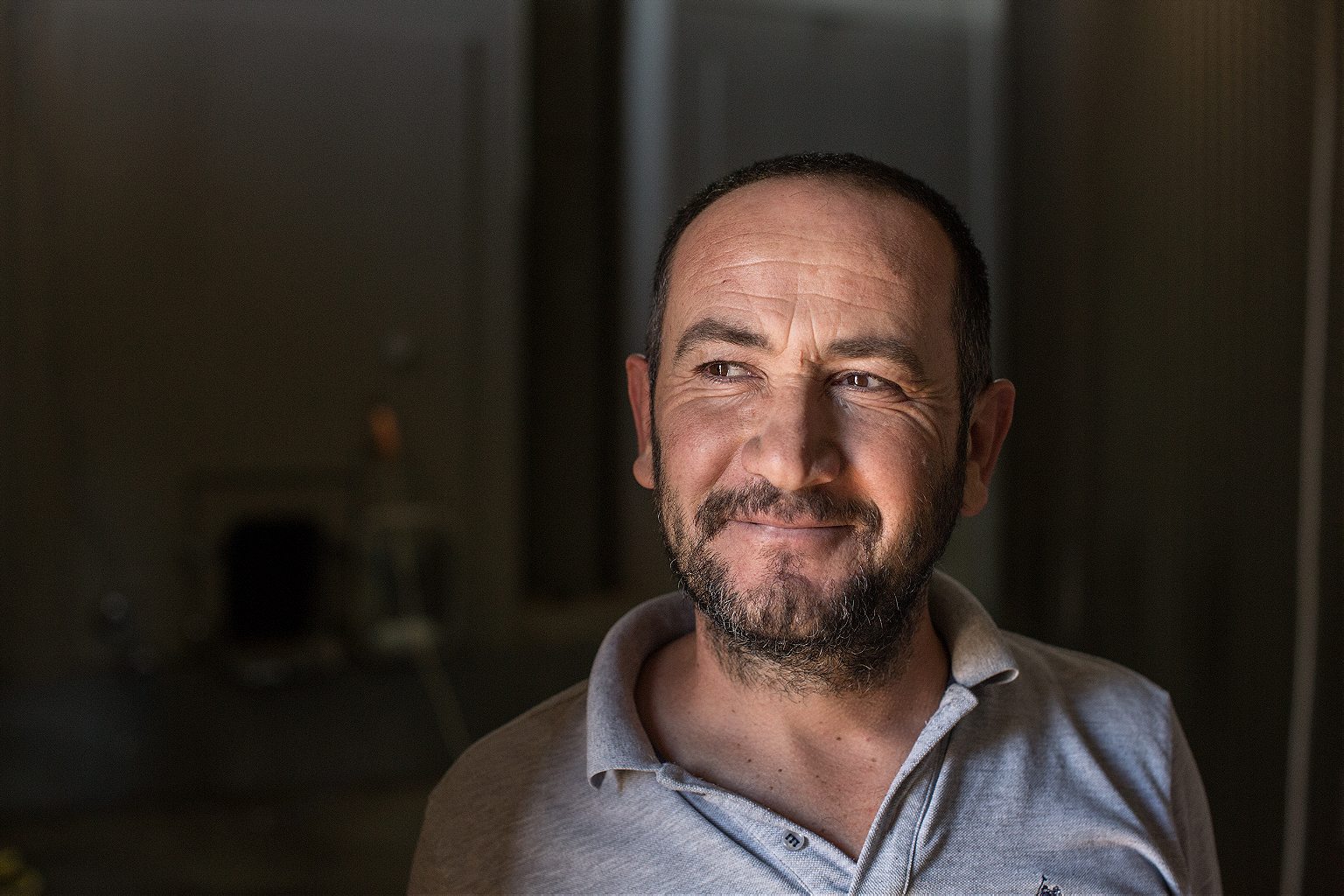
Cultivating legal crops, the co-op’s farmers are in a brutal business. Lebanon’s earlier wineries—there were five, including one run by brothers who slept in a vineyard with AK47s at their sides—nearly went extinct during the war. But since they found their footing in the 1990s, winemakers and oenophiles have resurrected wine culture in Lebanon.
Almost 50 wineries now operate in Lebanon, which is smaller than Connecticut. They offer tours and tastings, and have built open-air viewing stations and restaurants. They sell millions of bottles a year, in Lebanon and around the world. Chateau Ksara, started by Jesuit monks in 1857 and now Lebanon’s largest winery, churns out 3 million bottles a year near Zahle—a town, in the foothills of Mount Sannine, which is home to a third of Lebanon’s wineries. Other large wineries—Chateau Kefraya, which produces around 2 million bottles a year, or Chateau Musar which churns out at least 600,000—produce wine at an impressive, though not yet global, scale.
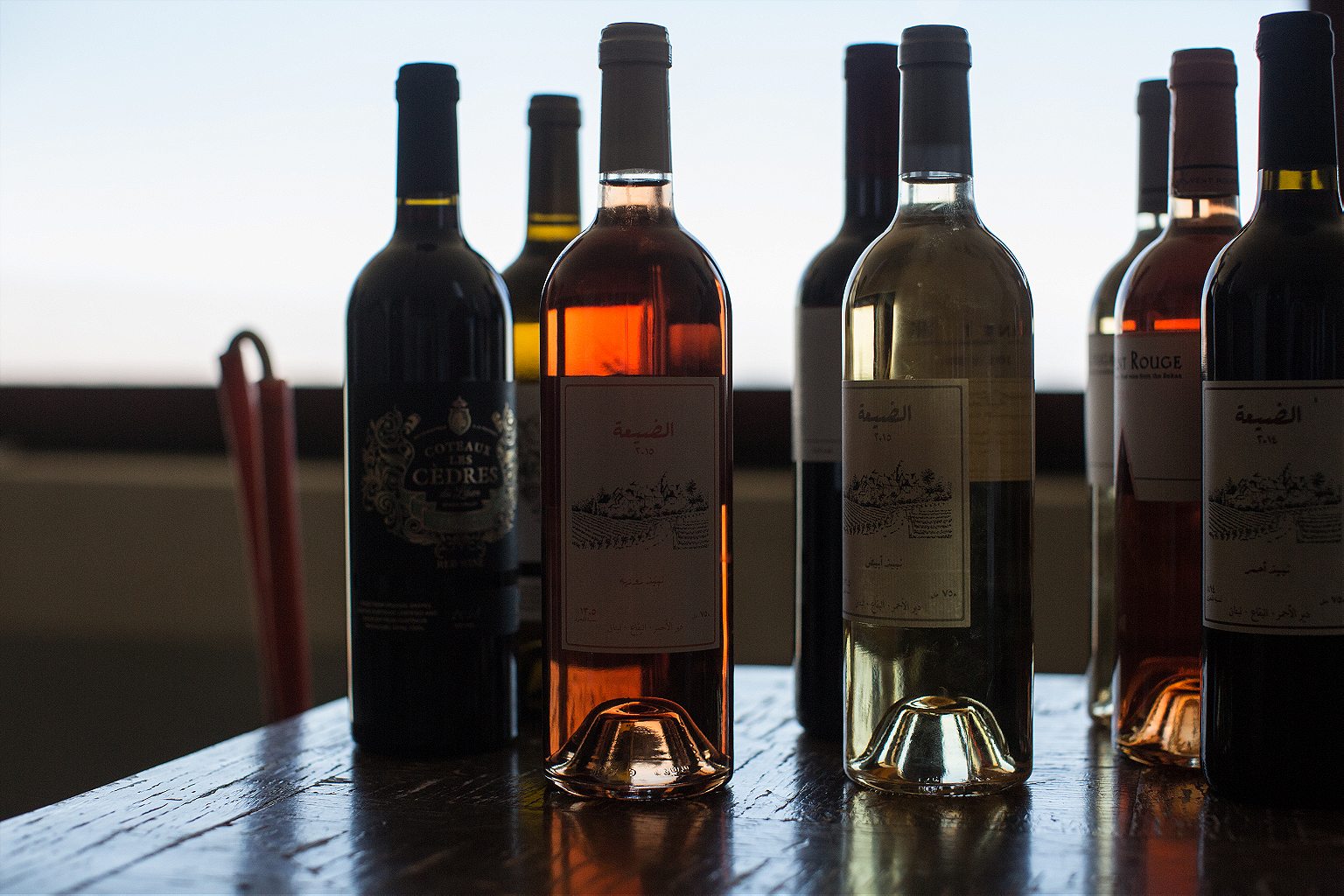
Couvent Rouge, meanwhile, bottles around 30,000 wines a year under its own label. “We are trying to compete with these [big brands],” Habshi says. “There are so many good wines. And we’re of course competing with other regions: Zahle, the West Bekaa—traditional winemaking areas.”
They’re also up against the world. Italian producers, for instance, make around 4 billion bottles of wine a year. Even Cyprus, where the climate is much like the drier parts of Lebanon, churns out 35 million bottles a year—four times Lebanese production. “The trick is to sell the country before the producer,” Karam, the author of Lebanese Wines, had explained earlier. “Most people know of Chilean wines, but I bet [they’d] be pushed to name a producer. If the government were smart, it would really get behind these producers.”
“What government?” Habshi sneers, sitting in the winery. He points to the horizon, and patchy plain below. “We’re on a different planet.”
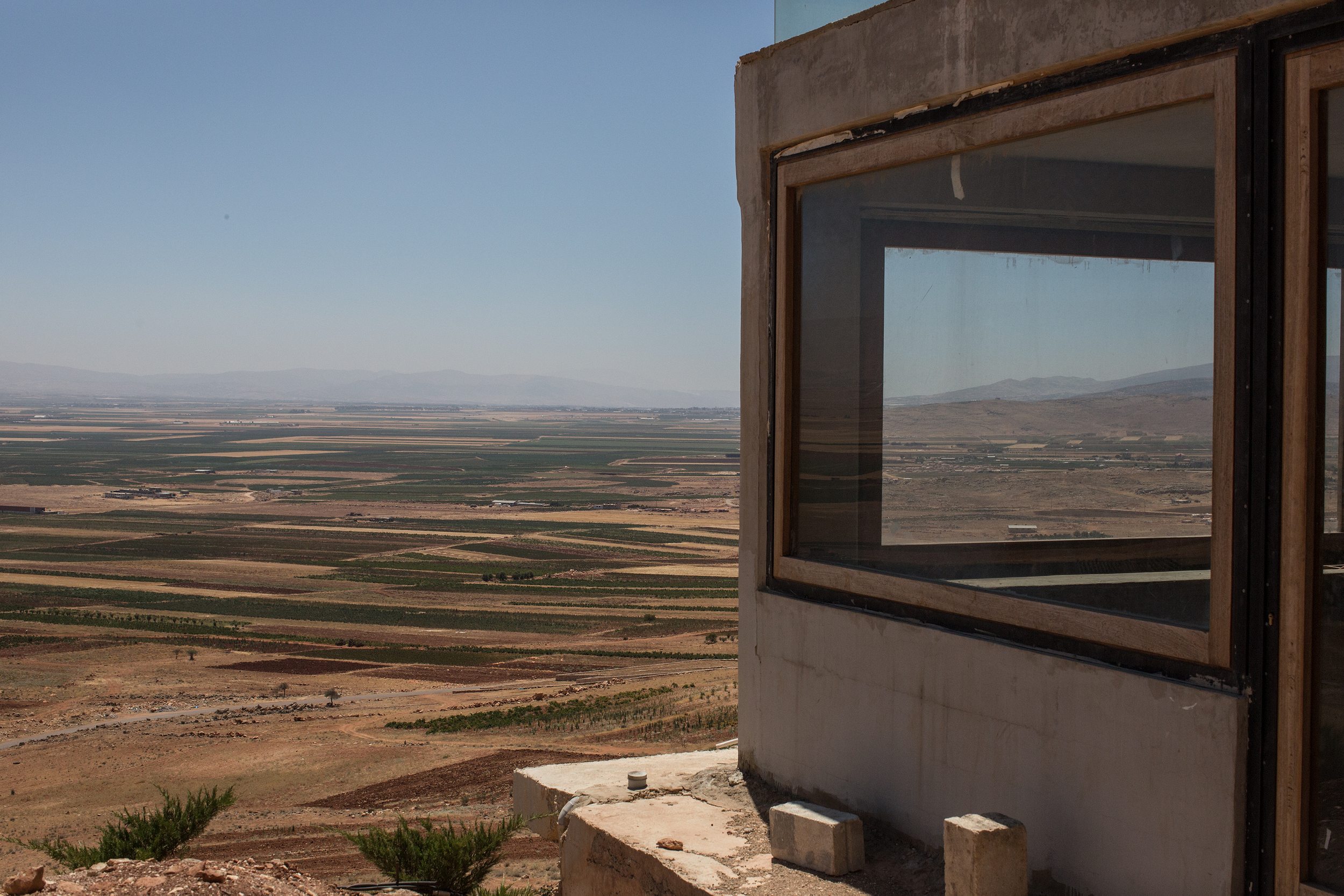
Habshi gets up. “Bring your glass!”
He wants to walk us through the winery, which is ultramodern but still under construction. It smells like a sugar factory. “Fermentation,” he notes, before explaining why they use concrete vats. “Concrete isn’t like wood, but it’s better than metal. It still interacts with the environment. It breathes, if you will.”
Habshi turns the taps, letting wine cascade into our glasses. Employees load shrubs and stones into some of the empty vats. We lean up against the cool wall, sniff the glasses—no whiff of hash, to be clear—and get to drinking again. “You might smell hash,” he says, sensing my struggle, “if you work with imagination!”
Face crinkling with glee, Habshi leads us up some stairs, through planned offices and processing facilities, and then down to a cavernous basement. “We make 100,000 bottles a year now,” he says, walking past walls and walls of stacked wine bottles. “We split the production. These bottles are for the Heliopolis Cooperative: Cedres and Day‘aa. See? And these are for us, Couvent Rouge.”
Hold on. If the winery is merely slapping different labels on the bottles, then it’s just selling more bullshit branding to consumers obsessed with contrived authenticity, fake origin stories, elegant logos, and—
“No, no. Look… We use different grapes and blends. Each label has its own taste. The co-op is still important to us, so we bottle its wines to reduce the risks for farmers.”
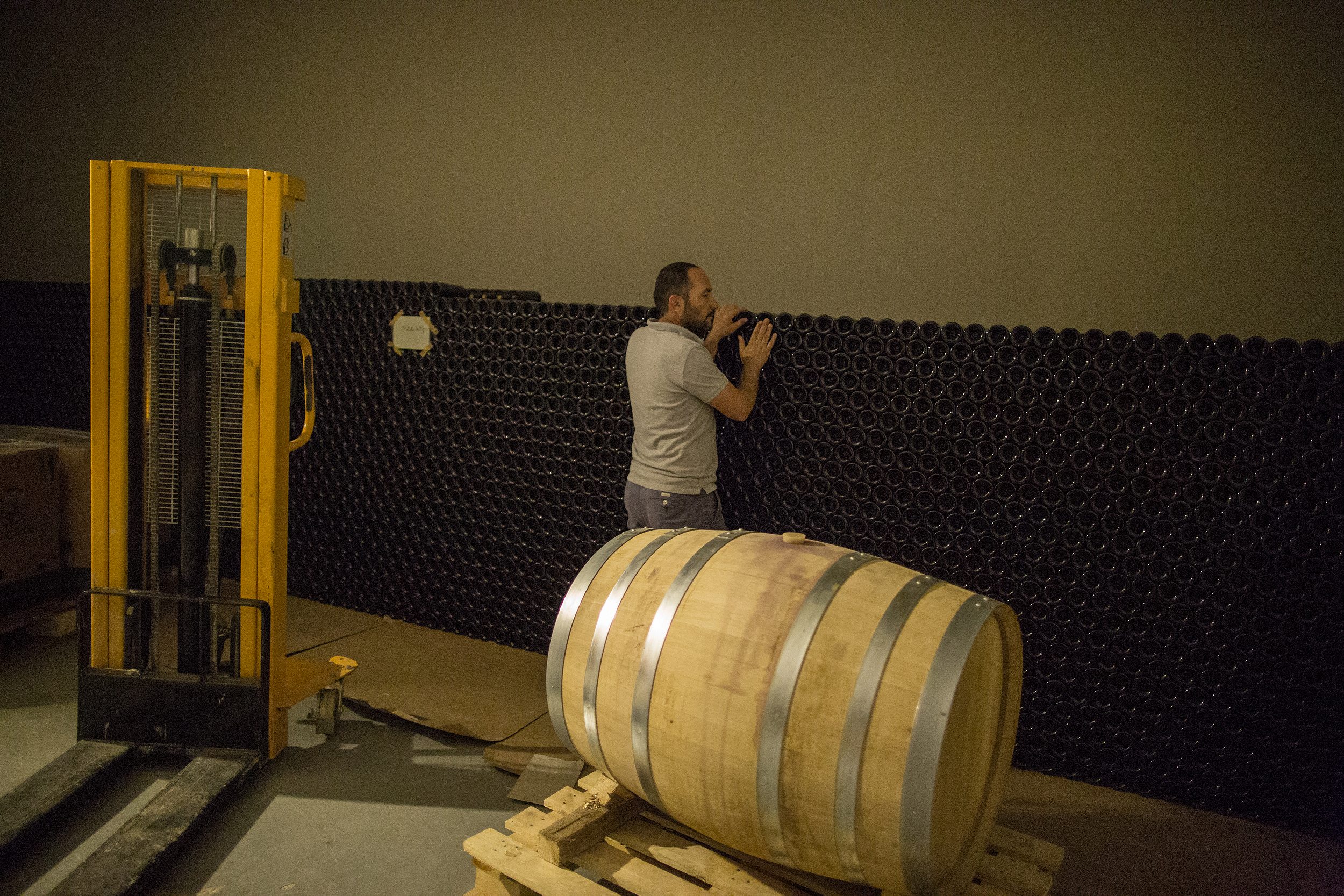
After we step onto a patio that has been the scene of some “outrageous parties,” Habshi and his employee Elie drive us around the lands and towns that surround the winery. Racing past young vineyards, a shepherd tending to his flock, and a golden hill where barley’s been cut, we take in fertile fields and orchards: grapes, tobacco, apples, figs, wheat, an errant sunflower, and more.
Cannabis grows everywhere. It grows by the road, across the vineyards, and on the hills. It grows in peoples’ goddamn gardens, with kids playing on balconies above.
While the Heliopolis Cooperative seems to have succeeded, it’s still a small enterprise. It produces fewer grapes than other vineyards. And its farmers own less than one-thirtieth the land held by their cannabis-cultivating counterparts in the area, to say nothing about the rest of the Bekaa Valley.
Grapes will not replace cannabis in Lebanon anytime soon, if ever
Many farmers have stuck with cannabis. Lebanese authorities have, as Habshi puts it, “left the area alone since 2011 or maybe 2012.” With cannabis production soaring by more than 30 percent, Lebanon is again among the world’s top five cannabis—or cannabis resin—producers. Drug lords are back in black, even finding time to do cutesy spots for VICE or the BBC like CEOs doing bizarre “sponsored content” profiles.
And Lebanon’s winemaking sector is still small—with total revenue less than $100 million dollars, and export-generated profits of less than $20 million—compared to the $6 billion dollars that the Lebanese are estimated to pocket from hash, heroin, and synthetic drugs like the Captagon craved by fighters in Syria and partygoers in the Arab Gulf. Without resource-aggregating ventures like the Helipolis Cooperative or value-adding enterprises like Couvent Rouge, farmers would have to sell their grapes—legal, and thus cheap—under contract, shaving something like 15 percent from their sale price.
Grapes will not replace cannabis in Lebanon anytime soon, if ever. While many farmers prefer grapes to other crops—and certainly to ones like potatoes, that yield poor returns—they need enterprises like the Heliopolis Cooperative to make their transition feasible and attractive. “It’s a no-brainer,” Karam says. “But it’s not that straightforward.” They need “at least three years before the vines can produce. What do they do in the meantime?”
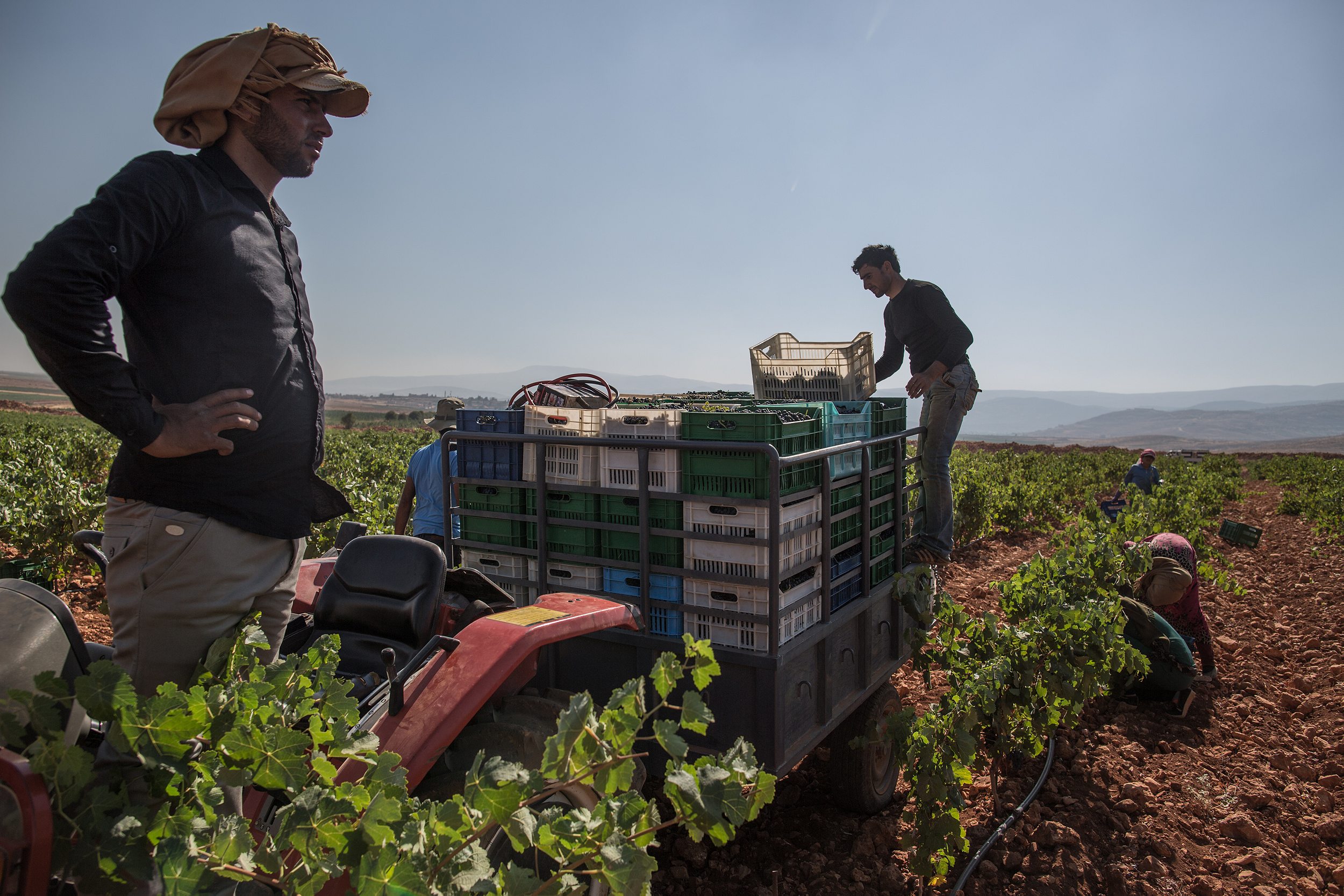
Elie drives us out to meet Habshi’s brother, Melhem, who’s out with his picking crew today. We abandon the truck in the middle of the road and walk over.
Melhem smiles uneasily. Not one to waste time, he’d just been blasting his brother on the phone. “Who? What do you mean questions and pictures? Fuck that shit,” we overhear him yelling.
A wiry man, Melhem’s sporting green shorts and a white undershirt that pops in the sun. “Who has my lighter?” he bellows, half-seriously. “My lighter…”
“I do,” Rasha smiles, eyes sparkling. She fishes the lighter out of her shirt, hands it over, and says hello. Like most of Melhem’s crew, Rasha is Syrian—from Homs, which, as she reminds us, is renowned for the “beauty of its women”—now living in Lebanon.
“We work with them all year,” Melhem explains. “We try to have them help with the harvest. They work hard. They are very good people.”
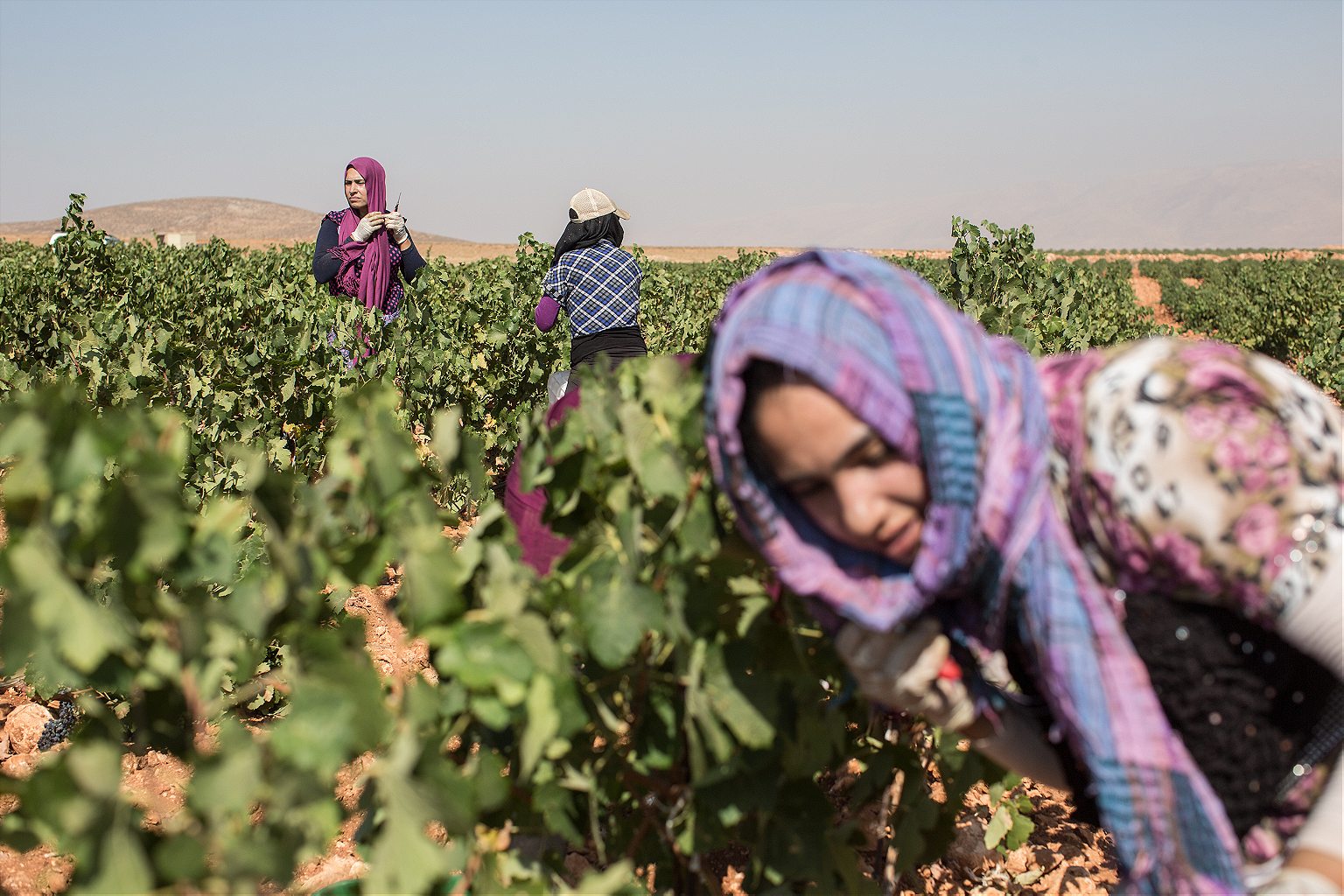
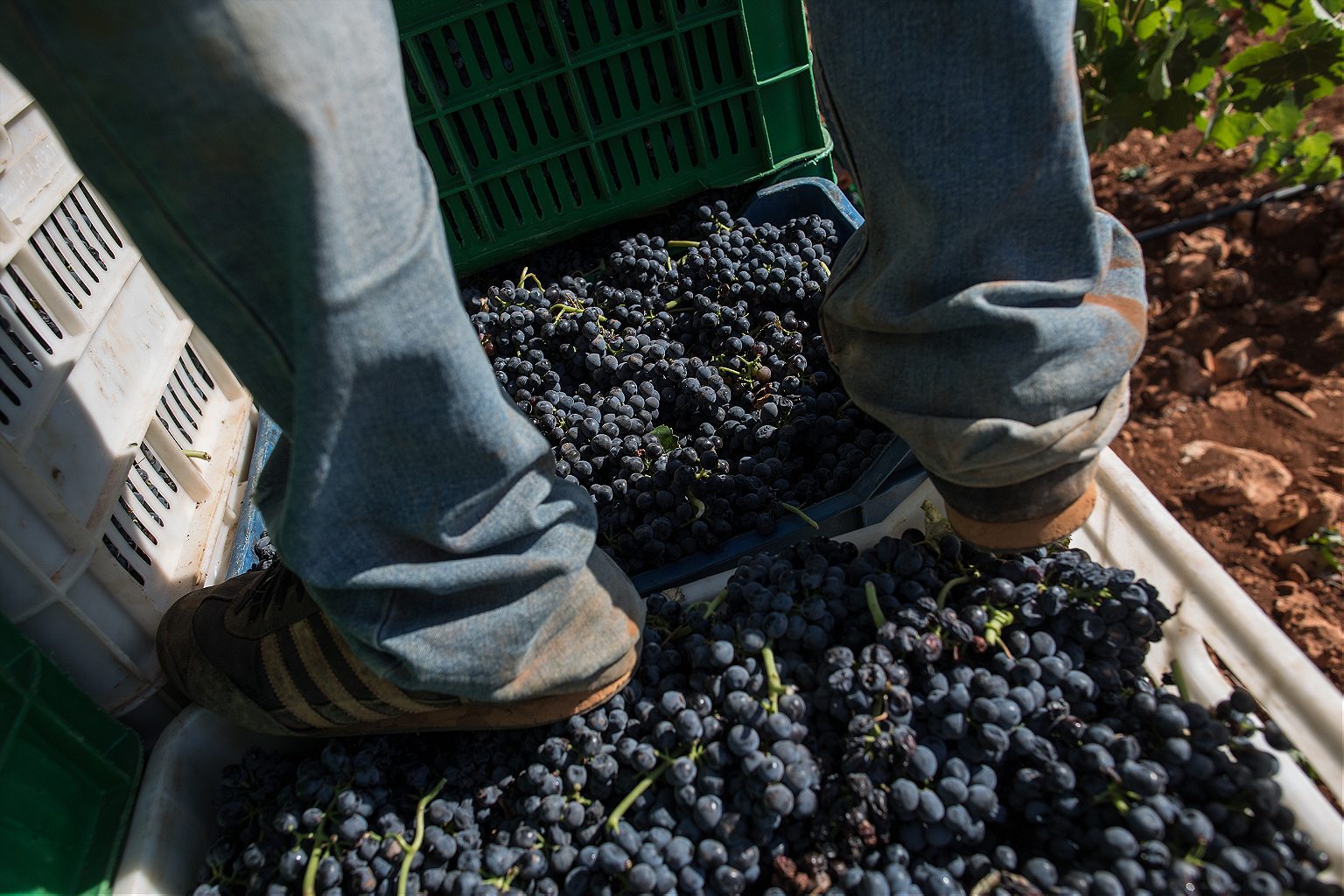
“Tell him to take pict—” Rasha yells, wind whipping her veil around.
I step closer, laughing. “What?”
She’s still struggling with the veil. “Pictures!” another woman yells. “The pictures!”
“You want [Sam] to take someone else’s picture? It’s only about the winery, I promise.”
“No!” she laughs loudly. “I don’t want him taking anyone else’s picture… Only mine!”
Melhem says he’s worked with some of the fruit pickers since before the Syrian war began in 2011, but that he’s seen more people looking for work since then. He pays each worker “2000LL,” or $1.33, an hour—something like twelve dollars a day.
While the Heliopolis Cooperative is a project of, by, and for Lebanese farmers, Melhem worries about the bottom line. “We couldn’t find enough Lebanese people to do this work even before the [Syrian] war,” he says, repeating a refrain heard across Lebanon. “I know only a few Lebanese that will work for 5000L or maybe 4000LL [an hour]. But, day after day, that is a lot more for us to bear.”
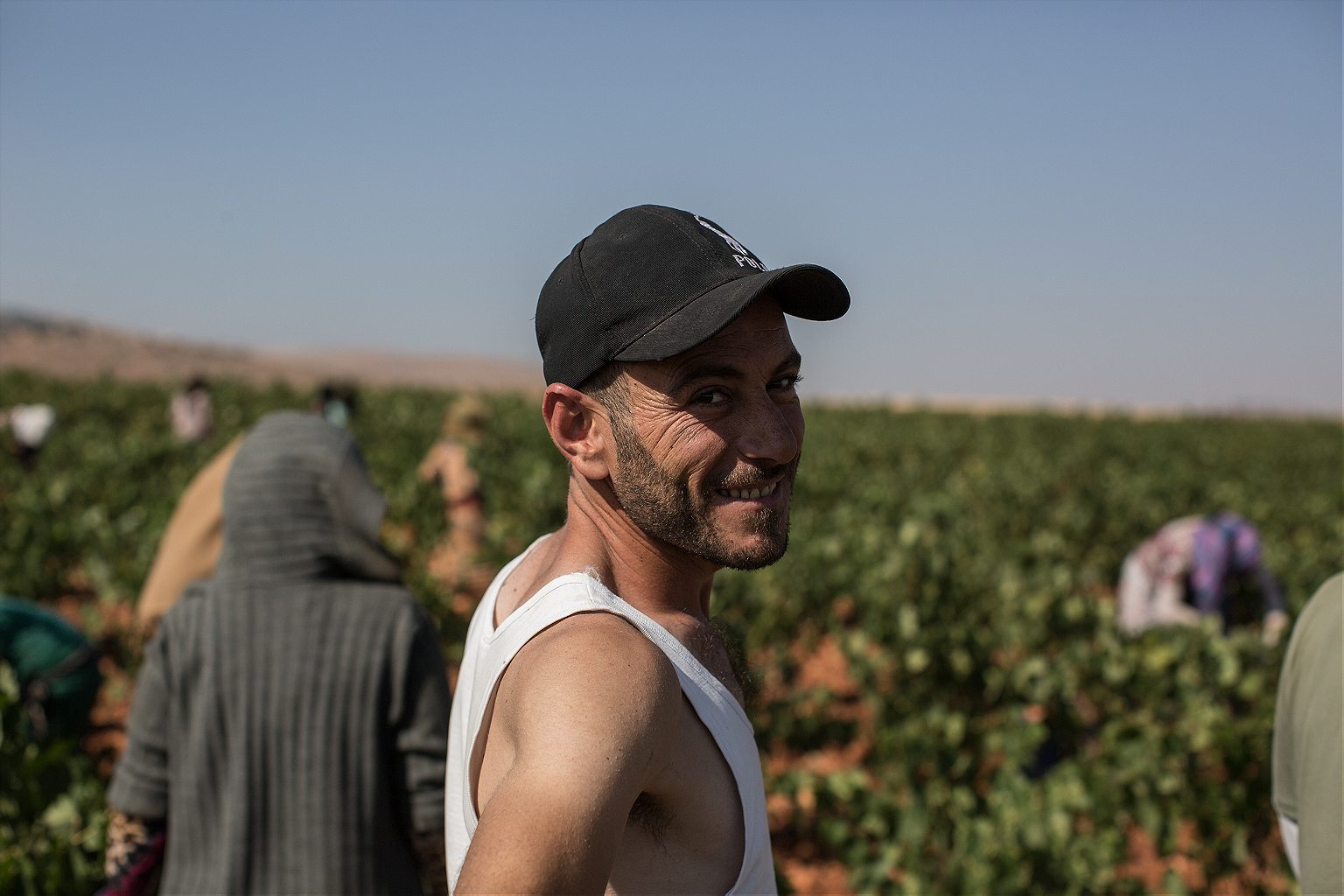
Sauntering through rows of Syrah and Tempranillo, Melhem explains how the Heliopolis Cooperative serves as a useful intermediary for farmers. “When we started out, we didn’t know much about grapes. It took about four years. We made mistakes. All the while, the government did nothing for us! I think some of the ministers worry about alcohol. Haram, eh? No, they prefer guns…”
The co-op stepped in. It simplified issues relating to land titles, eased the banks’ credit-risk concerns, secured more favorable loans, and backstopped farmers financially—thereby making the transition from the drug trade, which still dwarfs winemaking in terms of revenue, much more attractive than it otherwise would have been. The farmers then focused on “when to trim, what to spray, when to load, and which grapes to grow.”
Incidentally, the grapes are delicious. “Syrah is the best,” Melham declares, handing me a handful. They pop like blueberries, with a nice kick. “It struggles sometimes, not just in Lebanon. Syrah is the most important grape in the world. You just can’t make a good wine without Syrah!”
Elie points with pride at a smaller patch, one of two that he owns. “That’s mine. It took two years to sort out the land. It was too dry, and we couldn’t get a reliable supply of water over.”
Rolling the truck up the road, Elie—who’s spent most of the day smiling shyly—opens up. “So, are you liking Lebanon?”
“I love it… really.”
“Good!” He keeps looking over, smiling. We’ve been bonding a bit, swapping crazy stories about our ancestral villages—both known for gun-toting, temperamental, boisterous residents. Like many Lebanese, Elie has relatives abroad and a rather touching affinity for Lebanese-origin folks—emigres, or their sons and daughters—traveling through the Old Country. “Do you visit your village much?”
“Not like before.”
“You should always visit,” he says. We hit a bump. Happily, Sam—standing on the truck bed—is still with us, though I’m not sure flying face-first into a field of cannabis would be so bad.
“Will you stay?” Elie asks.
“I’d like to.”
“I hope you stay,” he says. “I don’t like when people leave Lebanon. We all have cousins in America and Australia. Why? Now I can stay, growing grapes and doing other work in the winter. God willing, you’ll stay here. And Sam! Visit us from time to time. Now this town is your home.”

Heading back to Beirut, we take a shortcut through the ski town of Faraya and nearby Ajaltoun. Carlos Khachan, the proprietor of Wine & More and a brand manager for the Heliopolis Cooperative, has twice invited us to join him for a “private wine-tasting.”
Sounds classy. We’re in.
Bearish and gregarious, Khachan smiles from behind the storefront. After twenty minutes of niceties, we sit with some of his friends.
Joseph, a sweet kid who works in the store, likes wines that fit his personality—causing some consternation among the seasoned snobs. “If you like sweet wines, then you’re still developing a taste for wine.” Linda, a lovely lady, tastes patiently and takes notes on her phone. “I like that one,” she says, leaning over. “I’m surprised.” She takes smoking breaks, much to Khachan’s chagrin, with Michel—a suave dude who’s roared up a M3 BMW. Michel seems to be here a lot; neither he nor Khachan can remember which vintages he likes—or when he’s bought them. “Are you going to party after this?” he grins, after a few glasses. “Don’t mix alcohols!” And then there’s Chawqi, a genteel man who lets his love of wine shine. He has sips of this and bites of that, while politely conversing with Sam about Merry Old England.
Sam and I sit at the end, trying to stay out of everyone’s way—and out of Khachan’s crosshairs. No dice.
“What do you taste?” he asks, as we try Australian, French, and Lebanese wines. “How do you rate [the wines]?”
We drink the wine; they make love to it, gurgling and puckering their way to a concealed climax. We smell soap, taste olive oil, or insist that there’s a touch of lavender; they say that the flavors we detect—the flavors that our minds, noses, and tongues are searching for—are citrus, berries, or spice. “It’s a science,” Khachan says, before softening the blow. “But it is imprecise. Taste matters. There is no ‘best wine,’ but there is a correct way to taste.”
At the moment of truth, though, we all agree: the Cedres red is excellent—not a gimmick. “That really was delicious,” Linda giggles. “Can I have some more?”
Writing a book about Lebanon’s “wine road,” Akar’s identifying and mapping out wineries that “have two things in common: fun wines and compelling, real stories.” He decants the wine, insisting that we taste it in phases, then explains how he first found these farmers. “We were buying new products for the bar, and a distributor told me to just try it. It was super-good!”

After a long, rambling conversation filled with impassioned asides and tangential rants, Akar rips through the pretention, pseudo-science, and bullshit often offered by oenophiles around the world.
“There’s no formula for what makes a good wine,” he explains, picking up steam. “Wine should be good, fun. It’s simple. But that doesn’t mean I can explain it. I like the wines that I like. I hope people drink wines they like, not wines they’re told to like.”
Akar pauses. He rakes his hair, searching for words.
“What I really like about this wine is that it’s simple and fun—like my grandfather’s batches. He used to make wine. For me, this wine is about a nostalgia that we’ve been talking about. Our grandparents, these farmers. They make good wine. And, yes, their story matters.”